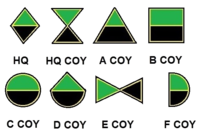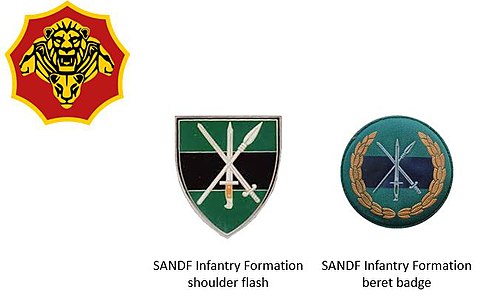
The Coldstream Guards is the oldest continuously serving regular regiment in the British Army. As part of the Household Division, one of its principal roles is the protection of the monarchy; due to this, it often participates in state ceremonial occasions. The Regiment has consistently provided formations on deployments around the world and has fought in the majority of the major conflicts in which the British Army has been engaged.
The South African 2nd Infantry Division was an infantry division of the army of the Union of South Africa during World War II. The division was formed on 23 October 1940 and served in the Western Desert Campaign and was captured by German and Italian forces at Tobruk on 21 June 1942. The remaining brigade was re-allocated to the South African 1st Infantry Division.

The Argyll and Sutherland Highlanders (Princess Louise's) is a light infantry company (designated as Balaklava Company, 5th Battalion, Royal Regiment of Scotland) and was a line infantry regiment of the British Army that existed from 1881 until amalgamation into the Royal Regiment of Scotland on 28 March 2006.
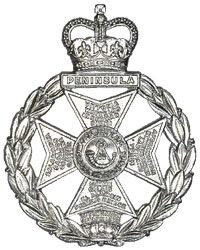
The Royal Green Jackets (RGJ) was an infantry regiment of the British Army, one of two "large regiments" within the Light Division.

The Cape Town Highlanders is a reserve mechanised infantry regiment of the South African Army.

The Bambatha Rifles is a reserve mechanised infantry regiment of the South African Army.

The Canterbury, and Nelson-Marlborough and West Coast Regiment was a Territorial Force unit of the New Zealand Army.
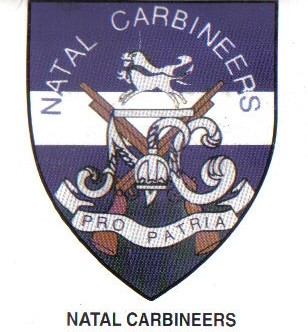
The Ingobamakhosi Carbineers is an infantry unit of the South African Army.

The Johannesburg Light Horse Regiment, is a reserve armoured car reconnaissance unit of the South African Army.

The Queen Nandi Mounted Rifles is an reserve armoured regiment of the South African Army.

The Umvoti Mounted Rifles is an armoured regiment of the South African Army. As a reserve unit, it has a status roughly equivalent to that of a British Army Reserve or United States Army National Guard unit. It is part of the South African Army Armour Formation and is based in the town of Pinetown.

The King's Own Yorkshire Light Infantry (KOYLI) was a light infantry regiment of the British Army. It officially existed from 1881 to 1968, but its predecessors go back to 1755. In 1968, the regiment was amalgamated with the Somerset and Cornwall Light Infantry, the King's Shropshire Light Infantry and the Durham Light Infantry to form The Light Infantry, which in turn was merged with the Devonshire and Dorset Regiment, the Royal Gloucestershire, Berkshire and Wiltshire Regiment and the Royal Green Jackets to become The Rifles in 2007.
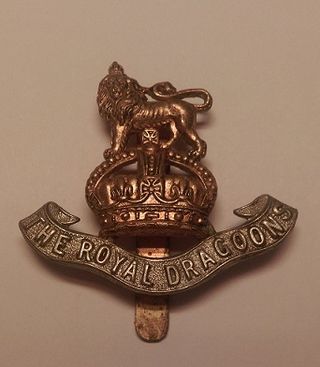
The Royal Dragoons was a heavy cavalry regiment of the British Army. The regiment was formed in 1661 as the Tangier Horse. It served for three centuries and was in action during the First and the Second World Wars. It was amalgamated with the Royal Horse Guards to form The Blues and Royals in 1969.

The Royal Sussex Regiment was a line infantry regiment of the British Army that was in existence from 1881 to 1966. The regiment was formed in 1881 as part of the Childers Reforms by the amalgamation of the 35th Regiment of Foot and the 107th Regiment of Foot. The regiment saw service in the Second Boer War, and both World War I and World War II.
The South African 1st Infantry Brigade was an infantry brigade of the army of the Union of South Africa during World Wars I and II. During World War I, the Brigade served as a British formation in Egypt and on the Western Front, most famously the Battle of Delville Wood. It was reactivated at the start of the Second World War as a South African formation and served in East Africa and the Western Desert; the Brigade disbanded on 1 January 1943.
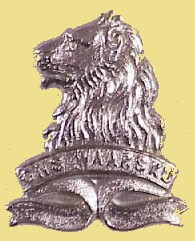
The General de la Rey Regiment is an reserve infantry regiment of the South African Army.

Regiment Port Natal was a motorised infantry regiment of the South African Army. It formed part of the South African Army Infantry Formation. As a reserve unit, it had a status roughly equivalent to that of a present-day British Army Reserve or United States Army National Guard unit.
The Sunderland Rifles was a Volunteer unit of the British Army formed in 1860. It went on to become a Battalion of the Durham Light Infantry (DLI) in the Territorial Force and saw action as infantry and pioneers in some of the bloodiest actions on the Western Front during World War I. Between the wars it became an air defence unit, serving during World War II in The Blitz and the campaign in North West Europe, when it had a special role in the Rhine crossing. Postwar it continued in the Territorial Army in the air defence role until 1975, when its successor unit reverted to infantry.

The 12th Motorised Brigade (South Africa) was a South African brigade-level infantry unit that served with the Allies in the Italian Campaign of World War II under the 6th South African Armoured Division. It was the first South African unit to enter combat in Italy. The unit was activated in 1943 and had generally deactivated by 8 May 1945.

